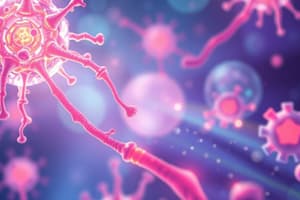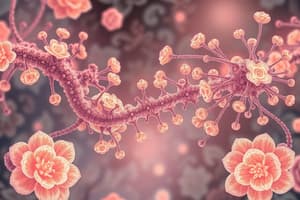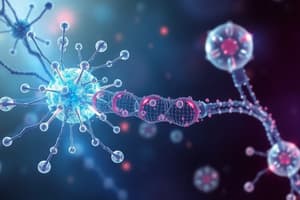Podcast
Questions and Answers
What is the intrinsic activity of a full agonist?
What is the intrinsic activity of a full agonist?
- Variable intrinsic activity
- 100% intrinsic activity (correct)
- 50% intrinsic activity
- 0% intrinsic activity
What characterizes a partial agonist in drug-receptor interaction?
What characterizes a partial agonist in drug-receptor interaction?
- Binds with lower affinity than an agonist
- Produces maximal effects
- Has no affinity for the receptor
- Produces only partial effects despite full occupancy (correct)
How do antagonists function in drug-receptor interactions?
How do antagonists function in drug-receptor interactions?
- Bind with low affinity to receptors
- Act as full agonists at lower concentrations
- Block stimulation without intrinsic activity (correct)
- Increase the effects of agonists
What effect does increasing drug dosage have on response according to the dose-response relationship?
What effect does increasing drug dosage have on response according to the dose-response relationship?
What is a subeffective dose?
What is a subeffective dose?
What advantage does a logarithmic scale provide in dose-response curves?
What advantage does a logarithmic scale provide in dose-response curves?
What is the best definition of a dose-response curve?
What is the best definition of a dose-response curve?
What is the role of the ligand binding domain in drug-receptor interactions?
What is the role of the ligand binding domain in drug-receptor interactions?
What does the KD value indicate about a ligand and its receptor?
What does the KD value indicate about a ligand and its receptor?
Which of the following best describes intrinsic activity in pharmacodynamics?
Which of the following best describes intrinsic activity in pharmacodynamics?
What is the primary difference between full agonists and partial agonists?
What is the primary difference between full agonists and partial agonists?
Which of the following terms describes the concept of a drug's therapeutic index?
Which of the following terms describes the concept of a drug's therapeutic index?
What is desensitization in the context of receptor pharmacology?
What is desensitization in the context of receptor pharmacology?
How do competitive antagonists affect receptor activity?
How do competitive antagonists affect receptor activity?
What characterizes the therapeutic window of a drug?
What characterizes the therapeutic window of a drug?
What occurs during receptor-mediated signal transduction?
What occurs during receptor-mediated signal transduction?
What does the therapeutic index measure?
What does the therapeutic index measure?
What happens when a drug has a low therapeutic index?
What happens when a drug has a low therapeutic index?
What is desensitization in receptor regulation?
What is desensitization in receptor regulation?
What is the effect of upregulation?
What is the effect of upregulation?
What is defined as potentiation in drug interactions?
What is defined as potentiation in drug interactions?
Which of the following does NOT describe additive effects?
Which of the following does NOT describe additive effects?
What is downregulation in the context of receptor activity?
What is downregulation in the context of receptor activity?
What is the median effective dose (ED50)?
What is the median effective dose (ED50)?
What does the ceiling effect refer to in pharmacology?
What does the ceiling effect refer to in pharmacology?
In the Two-state Receptor Theory, what is the primary result of ligand binding?
In the Two-state Receptor Theory, what is the primary result of ligand binding?
What does efficacy measure in the context of drug effects?
What does efficacy measure in the context of drug effects?
What is the significance of EC50 in pharmacology?
What is the significance of EC50 in pharmacology?
How does competitive antagonism affect an agonist's response curve?
How does competitive antagonism affect an agonist's response curve?
What characterizes noncompetitive antagonism in pharmacological terms?
What characterizes noncompetitive antagonism in pharmacological terms?
What is the key concept behind dose-effect relationships involving toxicity?
What is the key concept behind dose-effect relationships involving toxicity?
Which of the following statements about potency is correct?
Which of the following statements about potency is correct?
Flashcards are hidden until you start studying
Study Notes
Pharmacodynamics Overview
- Pharmacodynamics explores how drugs interact with biological systems through receptor engagement.
- Drug effects are mediated by receptors on target cells, altering cellular activities and organ function.
Receptors
- Defined as cellular macromolecules that interact with drugs to trigger biochemical events.
- Types of ligands that act on receptors: neurotransmitters, ions, hormones, immunoglobulins, lipoproteins, carbohydrates, and exogenous drugs.
Affinity and Intrinsic Activity
- KD indicates the concentration of ligand at which 50% of receptors are occupied; a lower KD signifies higher affinity.
- Efficacy measures the ability of a drug to produce an effect after binding to a receptor.
Receptor-Mediated Signal Transduction
- Includes a sequence: reception, activation of effectors, transduction, cellular response, signal amplification, and feedback regulation.
- The physiological processes are controlled by receptors, regulated by endogenous molecules.
Types of Agonists and Antagonists
- Full agonists elicit maximum response and have 100% intrinsic activity.
- Partial agonists bind fully but produce only partial effects.
- Antagonists block receptor activation without producing significant intrinsic activity.
Dose-Response Relationships
- The response to drug doses typically follows a non-linear relationship; low doses yield incremental responses which diminish at higher doses.
- Graded dose-response curves depict varying effects with increasing doses, while quantal curves show the drug's effect across a population.
Dose-Response Curves
- Arithmetic scale is less effective for large dose differences; it obscures changes in high concentrations.
- Logarithmic scale allows clearer visualization of drug effects and facilitates easier comparison across drugs.
Concepts of Efficacy and Potency
- Efficacy defines the maximum achievable effect of a drug, while potency measures the required dose for a specific effect.
- ED50 defines the effective dose for 50% of the population; EC50 indicates the concentration for half of the maximal response.
Types of Antagonism
- Competitive antagonism occurs when an antagonist competes with an agonist for binding, shifting the agonist’s curve to the right.
- Non-competitive antagonism results from irreversible binding or slow dissociation, depressing maximum response while shifting the curve rightward.
Therapeutic Index
- Therapeutic Index (TI) is the safety ratio of median lethal dose (LD50) to median effective dose (ED50).
- A higher TI indicates a safer drug with a larger margin before toxicity occurs.
Regulation of Receptors
- Receptors undergo adaptation through desensitization (reduced response despite continued stimulation) and can be upregulated (increased receptor number) or downregulated (decreased receptor number).
- Covalent modifications and association with regulatory proteins also influence receptor activity.
Drug Interactions
- Synergism occurs when the combined effect of two drugs is greater than the sum of their individual effects.
- Additive effects represent the straightforward sum of effects from two drugs.
- Potentiation refers to a scenario where one drug enhances the effect of another, even if it does not elicit a response by itself.
Studying That Suits You
Use AI to generate personalized quizzes and flashcards to suit your learning preferences.





